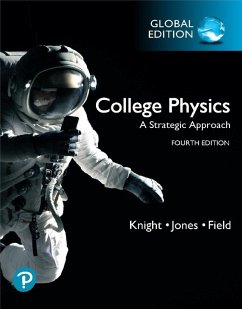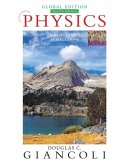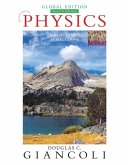- Broschiertes Buch
- Merkliste
- Auf die Merkliste
- Bewerten Bewerten
- Teilen
- Produkt teilen
- Produkterinnerung
- Produkterinnerung
Intended for algebra-based introductory physics courses. Building on the research-proven instructional techniques introduced in KnightGÇÖs Physics for Scientists and Engineers, College Physics: A Strategic Approach sets a new standard for algebra-based introductory physicsGÇögaining widespread critical acclaim from professors and students alike. The text, supplements, and optional MasteringPhysics-« work together to help students see and understand the big picture, gain crucial problem-solving skills and confidence, and better prepare for lecture and their future. For the 3rd Edition, Randy…mehr
Andere Kunden interessierten sich auch für
![Physics: Principles with Applications, Global Edition Physics: Principles with Applications, Global Edition]() Douglas GiancoliPhysics: Principles with Applications, Global Edition108,99 €
Douglas GiancoliPhysics: Principles with Applications, Global Edition108,99 €![Physics: Principles with Applications, Global Edition + Mastering Physics with Pearson eText (Package) Physics: Principles with Applications, Global Edition + Mastering Physics with Pearson eText (Package)]() Douglas GiancoliPhysics: Principles with Applications, Global Edition + Mastering Physics with Pearson eText (Package)117,99 €
Douglas GiancoliPhysics: Principles with Applications, Global Edition + Mastering Physics with Pearson eText (Package)117,99 €![Strategic Management: A Competitive Advantage Approach, Concepts, Global Edition Strategic Management: A Competitive Advantage Approach, Concepts, Global Edition]() Fred DavidStrategic Management: A Competitive Advantage Approach, Concepts, Global Edition109,99 €
Fred DavidStrategic Management: A Competitive Advantage Approach, Concepts, Global Edition109,99 €![Essential University Physics: Volume 1, Global Edition Essential University Physics: Volume 1, Global Edition]() Richard WolfsonEssential University Physics: Volume 1, Global Edition98,99 €
Richard WolfsonEssential University Physics: Volume 1, Global Edition98,99 €![Essential University Physics: Volume 2, Global Edition Essential University Physics: Volume 2, Global Edition]() Richard WolfsonEssential University Physics: Volume 2, Global Edition81,99 €
Richard WolfsonEssential University Physics: Volume 2, Global Edition81,99 €![Introduction to Communication Disorders: A Lifespan Evidence-Based Approach, Global Edition Introduction to Communication Disorders: A Lifespan Evidence-Based Approach, Global Edition]() Robert OwensIntroduction to Communication Disorders: A Lifespan Evidence-Based Approach, Global Edition101,99 €
Robert OwensIntroduction to Communication Disorders: A Lifespan Evidence-Based Approach, Global Edition101,99 €![Principles of Chemistry: A Molecular Approach, Global Edition Principles of Chemistry: A Molecular Approach, Global Edition]() Nivaldo TroPrinciples of Chemistry: A Molecular Approach, Global Edition85,99 €
Nivaldo TroPrinciples of Chemistry: A Molecular Approach, Global Edition85,99 €-
-
-
Intended for algebra-based introductory physics courses. Building on the research-proven instructional techniques introduced in KnightGÇÖs Physics for Scientists and Engineers, College Physics: A Strategic Approach sets a new standard for algebra-based introductory physicsGÇögaining widespread critical acclaim from professors and students alike. The text, supplements, and optional MasteringPhysics-« work together to help students see and understand the big picture, gain crucial problem-solving skills and confidence, and better prepare for lecture and their future. For the 3rd Edition, Randy Knight, Brian Jones and Stuart Field have incorporated student feedback and research to strengthen their focus on student learning, and to apply the best results from educational research and extensive user feedback and metadata. This program presents an unparalleled teaching and learning experience, uniquely effective and integrated. * Prepare for lecture: Prepare students for lecture with innovative and engaging media tools, tailored carefully to reinforce the textbook. * Understand the big picture: Enable students to understand the connections between topics, the real-world context, and the overarching themes, skills, and principles of physics using refined and expanded learning tools. * Develop problem-solving skills: Equip students with problem-solving tactics and strategies through expanded guidance and practice in the text and online in MasteringPhysics. * Foster skills for the MCAT: Gear students up for the new MCAT with enhanced life-science and biomedical applications in the text and problems, and increased emphasis on reasoning with real-world situations and data.
Hinweis: Dieser Artikel kann nur an eine deutsche Lieferadresse ausgeliefert werden.
Hinweis: Dieser Artikel kann nur an eine deutsche Lieferadresse ausgeliefert werden.
Produktdetails
- Produktdetails
- Verlag: Pearson Education Limited
- 4 ed
- Seitenzahl: 1168
- Erscheinungstermin: 16. Juni 2021
- Englisch
- Abmessung: 215mm x 275mm x 46mm
- Gewicht: 2420g
- ISBN-13: 9781292277769
- ISBN-10: 1292277769
- Artikelnr.: 61445065
- Herstellerkennzeichnung
- Libri GmbH
- Europaallee 1
- 36244 Bad Hersfeld
- gpsr@libri.de
- Verlag: Pearson Education Limited
- 4 ed
- Seitenzahl: 1168
- Erscheinungstermin: 16. Juni 2021
- Englisch
- Abmessung: 215mm x 275mm x 46mm
- Gewicht: 2420g
- ISBN-13: 9781292277769
- ISBN-10: 1292277769
- Artikelnr.: 61445065
- Herstellerkennzeichnung
- Libri GmbH
- Europaallee 1
- 36244 Bad Hersfeld
- gpsr@libri.de
* Full Version, All Chapters: Chs 1-30
* Volume 1: Chs 1-16
* Volume 2: Chs 17-30
PART I FORCE AND MOTION
* OVERVIEW The Science of Physics
1. Representing Motion
o 1.1 Motion: A First Look
o 1.2 Models and Modeling
o 1.3 Position and Time: Putting Numbers on Nature
o 1.4 Velocity
o 1.5 A Sense of Scale: Significant Figures, Scientific Notation,
and Units
o 1.6 Vectors and Motion: A First Look
o 1.7 Where Do We Go from Here?
o SUMMARY
o QUESTIONS AND PROBLEMS
1. Motion in One Dimension
* 2.1 Describing Motion
* 2.2 Uniform Motion
* 2.3 Instantaneous Velocity
* 2.4 Acceleration
* 2.5 Motion with Constant Acceleration
* 2.6 Solving One-Dimensional Motion Problems
* 2.7 Free Fall
* SUMMARY
* QUESTIONS AND PROBLEMS
2. Vectors and Motion in Two Dimensions
* 3.1 Using Vectors
* 3.2 Coordinate Systems and Vector Components
* 3.3 Motion on a Ramp
* 3.4 Motion in Two Dimensions
* 3.5 Projectile Motion
* 3.6 Projectile Motion: Solving Problems
* 3.7 Circular Motion
* 3.8 Relative Motion
* SUMMARY
* QUESTIONS AND PROBLEMS
3. Forces and Newton's Laws of Motion
* 4.1 Motion and Forces
* 4.2 A Short Catalog of Forces
* 4.3 Identifying Forces
* 4.4 What Do Forces Do?
* 4.5 Newton's Second Law
* 4.6 Free-Body Diagrams
* 4.7 Newton's Third Law
* SUMMARY
* QUESTIONS AND PROBLEMS
4. Applying Newton's Laws
* 5.1 Equilibrium
* 5.2 Dynamics and Newton's Second Law
* 5.3 Mass and Weight
* 5.4 Normal Forces
* 5.5 Friction
* 5.6 Drag
* 5.7 Interacting Objects
* 5.8 Ropes and Pulleys
* SUMMARY
* QUESTIONS AND PROBLEMS
5. Circular Motion, Orbits, and Gravity
* 6.1 Uniform Circular Motion
* 6.2 Dynamics of Uniform Circular Motion
* 6.3 Apparent Forces in Circular Motion
* 6.4 Circular Orbits and Weightlessness
* 6.5 Newton's Law of Gravity
* 6.6 Gravity and Orbits
* SUMMARY
* QUESTIONS AND PROBLEMS
6. Rotational Motion
* 7.1 Describing Circular and Rotational Motion
* 7.2 The Rotation of a Rigid Body
* 7.3 Torque
* 7.4 Gravitational Torque and the Center of Gravity
* 7.5 Rotational Dynamics and Moment of Inertia
* 7.6 Using Newton's Second Law for Rotation
* 7.7 Rolling Motion
* SUMMARY
* QUESTIONS AND PROBLEMS
7. Equilibrium and Elasticity
* 8.1 Torque and Static Equilibrium
* 8.2 Stability and Balance
* 8.3 Springs and Hooke's Law
* 8.4 Stretching and Compressing Materials
* 8.5 Forces and Torques in the Body
* SUMMARY
* QUESTIONS AND PROBLEMS
* PART I SUMMARY Force and Motion
* ONE STEP BEYOND Dark Matter and the Structure of the Universe
* PART I PROBLEMS
PART II CONSERVATION LAWS
* OVERVIEW Why Some Things Stay the Same
8. Momentum
* 9.1 Impulse
* 9.2 Momentum and the Impulse-Momentum Theorem
* 9.3 Solving Impulse and Momentum Problems
* 9.4 Conservation of Momentum
* 9.5 Inelastic Collisions
* 9.6 Momentum and Collisions in Two Dimensions
* 9.7 Angular Momentum
* SUMMARY
* QUESTIONS AND PROBLEMS
9. Energy and Work
* 10.1 The Basic Energy Model
* 10.2 Work
* 10.3 Kinetic Energy
* 10.4 Potential Energy
* 10.5 Thermal Energy
* 10.6 Conservation of Energy
* 10.7 Energy Diagrams
* 10.8 Molecular Bonds and Chemical Energy
* 10.9 Energy in Collisions
* 10.10 Power
* SUMMARY
* QUESTIONS AND PROBLEMS
10. Using Energy
* 11.1 Transforming Energy
* 11.2 Energy in the Body
* 11.3 Temperature, Thermal Energy, and Heat
* 11.4 The First Law of Thermodynamics
* 11.5 Heat Engines
* 11.6 Heat Pumps
* 11.7 Entropy and the Second Law of Thermodynamics
* 11.8 Systems, Energy, and Entropy
* SUMMARY
* QUESTIONS AND PROBLEMS
* PART II SUMMARY Conservation Laws
* ONE STEP BEYOND Order Out of Chaos
* PART II PROBLEMS
PART III PROPERTIES OF MATTER
* OVERVIEW Beyond the Particle Model
11. Thermal Properties of Matter
* 12.1 The Atomic Model of Matter
* 12.2 The Atomic Model of an Ideal Gas
* 12.3 Ideal-Gas Processes
* 12.4 Thermal Expansion
* 12.5 Specific Heat and Heat of Transformation
* 12.6 Calorimetry
* 12.7 Specific Heats of Gases
* 12.8 Heat Transfer
* 12.9 Diffusion
* SUMMARY
* QUESTIONS AND PROBLEMS
12. Fluids
* 13.1 Fluids and Density
* 13.2 Pressure
* 13.3 Buoyancy
* 13.4 Fluids in Motion
* 13.5 Fluid Dynamics
* 13.6 Viscosity and Poiseuille's Equation
* 13.7 The Circulatory System
* SUMMARY
* QUESTIONS AND PROBLEMS
* PART III SUMMARY Properties of Matter
* ONE STEP BEYOND Size and Life
* PART III PROBLEMS
PART IV OSCILLATIONS AND WAVES
* OVERVIEW Motion That Repeats Again and Again
13. Oscillations
* 14.1 Equilibrium and Oscillation
* 14.2 Linear Restoring Forces and SHM
* 14.3 Describing Simple Harmonic Motion
* 14.4 Energy in Simple Harmonic Motion
* 14.5 Pendulum Motion
* 14.6 Damped Oscillations
* 14.7 Driven Oscillations and Resonance
* SUMMARY
* QUESTIONS AND PROBLEMS
14. Traveling Waves and Sound
* 15.1 The Wave Model
* 15.2 Traveling Waves
* 15.3 Graphical and Mathematical Descriptions of Waves
* 15.4 Sound and Light Waves
* 15.5 Energy and Intensity
* 15.6 Loudness of Sound
* 15.7 The Doppler Effect and Shock Waves
* SUMMARY
* QUESTIONS AND PROBLEMS
15. Superposition and Standing Waves
* 16.1 The Principle of Superposition
* 16.2 Standing Waves
* 16.3 Standing Waves on a String
* 16.4 Standing Sound Waves
* 16.5 Speech and Hearing
* 16.6 The Interference of Waves from Two Sources
* 16.7 Beats
* SUMMARY
* QUESTIONS AND PROBLEMS
* PART IV SUMMARY Oscillations and Waves
* ONE STEP BEYOND Waves in the Earth and the Ocean
* PART IV PROBLEMS
PART V OPTICS
* OVERVIEW Light Is a Wave
16. Wave Optics
* 17.1 What Is Light?
* 17.2 The Interference of Light
* 17.3 The Diffraction Grating
* 17.4 Thin-Film Interference
* 17.5 Single-Slit Diffraction
* 17.6 Circular-Aperture Diffraction
* SUMMARY
* QUESTIONS AND PROBLEMS
17. Ray Optics
* 18.1 The Ray Model of Light
* 18.2 Reflection
* 18.3 Refraction
* 18.4 Image Formation by Refraction
* 18.5 Thin Lenses: Ray Tracing
* 18.6 Image Formation with Spherical Mirrors
* 18.7 The Thin-Lens Equation
* SUMMARY
* QUESTIONS AND PROBLEMS
18. Optical Instruments
* 19.1 The Camera
* 19.2 The Human Eye
* 19.3 The Magnifier
* 19.4 The Microscope
* 19.5 The Telescope
* 19.6 Color and Dispersion
* 19.7 Resolution of Optical Instruments
* SUMMARY
* QUESTIONS AND PROBLEMS
* PART V SUMMARY Optics
* ONE STEP BEYOND Scanning Confocal Microscopy
* PART V PROBLEMS
PART VI ELECTRICITY AND MAGNETISM
* OVERVIEW Charges, Currents, and Fields
19. Electric Fields and Forces
* 20.1 Charges and Forces
* 20.2 Charges, Atoms, and Molecules
* 20.3 Coulomb's Law
* 20.4 The Concept of the Electric Field
* 20.5 The Electric Field from Arrangements of Charges
* 20.6 Conductors and Electric Fields
* 20.7 Forces and Torques in Electric Fields
* SUMMARY
* QUESTIONS AND PROBLEMS
20. Electric Potential
* 21.1 Electric Potential Energy and Electric Potential
* 21.2 Sources of Electric Potential
* 21.3 Electric Potential and Conservation of Energy
* 21.4 Calculating the Electric Potential
* 21.5 Connecting Potential and Field
* 21.6 The Electrocardiogram
* 21.7 Capacitance and Capacitors
* 21.8 Energy and Capacitors
* SUMMARY
* QUESTIONS AND PROBLEMS
21. Current and Resistance
* 22.1 A Model of Current
* 22.2 Defining and Describing Current
* 22.3 Batteries and emf
* 22.4 Connecting Potential and Current
* 22.5 Ohm's Law and Resistor Circuits
* 22.6 Energy and Power
* SUMMARY
* QUESTIONS AND PROBLEMS
22. Circuits
* 23.1 Circuit Elements and Diagrams
* 23.2 Kirchhoff's Laws
* 23.3 Series and Parallel Circuits
* 23.4 Measuring Voltage and Current
* 23.5 More Complex Circuits
* 23.6 Capacitors in Parallel and Series
* 23.7 RC Circuits
* 23.8 Electricity in the Nervous System
* SUMMARY
* QUESTIONS AND PROBLEMS
23. Magnetic Fields and Forces
* 24.1 Magnetism
* 24.2 The Magnetic Field
* 24.3 Electric Currents Also Create Magnetic Fields
* 24.4 Calculating the Magnetic Field Due to a Current
* 24.5 Magnetic Fields Exert Forces on Moving Charges
* 24.6 Magnetic Fields Exert Forces on Currents
* 24.7 Magnetic Fields Exert Torques on Dipoles
* 24.8 Magnets and Magnetic Materials
* SUMMARY
* QUESTIONS AND PROBLEMS
24. EM Induction and EM Waves
* 25.1 Induced Currents
* 25.2 Motional emf
* 25.3 Magnetic Flux and Lenz's Law
* 25.4 Faraday's Law
* 25.5 Electromagnetic Waves
* 25.6 The Photon Model of Electromagnetic Waves
* 25.7 The Electromagnetic Spectrum
* SUMMARY
* QUESTIONS AND PROBLEMS
25. AC Electricity
* 26.1 Alternating Current
* 26.2 AC Electricity and Transformers
* 26.3 Household Electricity
* 26.4 Biological Effects and Electrical Safety
* 26.5 Capacitor Circuits
* 26.6 Inductors and Inductor Circuits
* 26.7 Oscillation Circuits
* SUMMARY
* QUESTIONS AND PROBLEMS
* PART VI SUMMARY Electricity and Magnetism
* ONE STEP BEYOND The Greenhouse Effect and Global Warming
* PART VI PROBLEMS
PART VII MODERN PHYSICS
* OVERVIEW New Ways of Looking at the World
26. Relativity
* 27.1 Relativity: What's It All About?
* 27.2 Galilean Relativity
* 27.3 Einstein's Principle of Relativity
* 27.4 Events and Measurements
* 27.5 The Relativity of Simultaneity
* 27.6 Time Dilation
* 27.7 Length Contraction
* 27.8 Velocities of Objects in Special Relativity
* 27.9 Relativistic Momentum
* 27.10 Relativistic Energy
* SUMMARY
* QUESTIONS AND PROBLEMS
27. Quantum Physics
* 28.1 X Rays and X-Ray Diffraction
* 28.2 The Photoelectric Effect
* 28.3 Photons
* 28.4 Matter Waves
* 28.5 Energy Is Quantized
* 28.6 Energy Levels and Quantum Jumps
* 28.7 The Uncertainty Principle
* 28.8 Applications and Implications of Quantum Theory
* SUMMARY
* QUESTIONS AND PROBLEMS
28. Atoms and Molecules
* 29.1 Spectroscopy
* 29.2 Atoms
* 29.3 Bohr's Model of Atomic Quantization
* 29.4 The Bohr Hydrogen Atom
* 29.5 The Quantum-Mechanical Hydrogen Atom
* 29.6 Multi-electron Atoms
* 29.7 Excited States and Spectra
* 29.8 Molecules
* 29.9 Stimulated Emission and Lasers
* SUMMARY
* QUESTIONS AND PROBLEMS
29. Nuclear Physics
* 30.1 Nuclear Structure
* 30.2 Nuclear Stability
* 30.3 Forces and Energy in the Nucleus
* 30.4 Radiation and Radioactivity
* 30.5 Nuclear Decay and Half-Lives
* 30.6 Medical Applications of Nuclear Physics
* 30.7 The Ultimate Building Blocks of Matter
* SUMMARY
* QUESTIONS AND PROBLEMS
* PART VII SUMMARY MODERN PHYSICS
* ONE STEP BEYOND The Physics of Very Cold Atoms
* PART VII PROBLEMS
APPENDICES
30. Mathematics Review
31. Periodic Table of Elements
32. Atomic and Nuclear Data
Answers to Odd-Numbered Problems
* Volume 1: Chs 1-16
* Volume 2: Chs 17-30
PART I FORCE AND MOTION
* OVERVIEW The Science of Physics
1. Representing Motion
o 1.1 Motion: A First Look
o 1.2 Models and Modeling
o 1.3 Position and Time: Putting Numbers on Nature
o 1.4 Velocity
o 1.5 A Sense of Scale: Significant Figures, Scientific Notation,
and Units
o 1.6 Vectors and Motion: A First Look
o 1.7 Where Do We Go from Here?
o SUMMARY
o QUESTIONS AND PROBLEMS
1. Motion in One Dimension
* 2.1 Describing Motion
* 2.2 Uniform Motion
* 2.3 Instantaneous Velocity
* 2.4 Acceleration
* 2.5 Motion with Constant Acceleration
* 2.6 Solving One-Dimensional Motion Problems
* 2.7 Free Fall
* SUMMARY
* QUESTIONS AND PROBLEMS
2. Vectors and Motion in Two Dimensions
* 3.1 Using Vectors
* 3.2 Coordinate Systems and Vector Components
* 3.3 Motion on a Ramp
* 3.4 Motion in Two Dimensions
* 3.5 Projectile Motion
* 3.6 Projectile Motion: Solving Problems
* 3.7 Circular Motion
* 3.8 Relative Motion
* SUMMARY
* QUESTIONS AND PROBLEMS
3. Forces and Newton's Laws of Motion
* 4.1 Motion and Forces
* 4.2 A Short Catalog of Forces
* 4.3 Identifying Forces
* 4.4 What Do Forces Do?
* 4.5 Newton's Second Law
* 4.6 Free-Body Diagrams
* 4.7 Newton's Third Law
* SUMMARY
* QUESTIONS AND PROBLEMS
4. Applying Newton's Laws
* 5.1 Equilibrium
* 5.2 Dynamics and Newton's Second Law
* 5.3 Mass and Weight
* 5.4 Normal Forces
* 5.5 Friction
* 5.6 Drag
* 5.7 Interacting Objects
* 5.8 Ropes and Pulleys
* SUMMARY
* QUESTIONS AND PROBLEMS
5. Circular Motion, Orbits, and Gravity
* 6.1 Uniform Circular Motion
* 6.2 Dynamics of Uniform Circular Motion
* 6.3 Apparent Forces in Circular Motion
* 6.4 Circular Orbits and Weightlessness
* 6.5 Newton's Law of Gravity
* 6.6 Gravity and Orbits
* SUMMARY
* QUESTIONS AND PROBLEMS
6. Rotational Motion
* 7.1 Describing Circular and Rotational Motion
* 7.2 The Rotation of a Rigid Body
* 7.3 Torque
* 7.4 Gravitational Torque and the Center of Gravity
* 7.5 Rotational Dynamics and Moment of Inertia
* 7.6 Using Newton's Second Law for Rotation
* 7.7 Rolling Motion
* SUMMARY
* QUESTIONS AND PROBLEMS
7. Equilibrium and Elasticity
* 8.1 Torque and Static Equilibrium
* 8.2 Stability and Balance
* 8.3 Springs and Hooke's Law
* 8.4 Stretching and Compressing Materials
* 8.5 Forces and Torques in the Body
* SUMMARY
* QUESTIONS AND PROBLEMS
* PART I SUMMARY Force and Motion
* ONE STEP BEYOND Dark Matter and the Structure of the Universe
* PART I PROBLEMS
PART II CONSERVATION LAWS
* OVERVIEW Why Some Things Stay the Same
8. Momentum
* 9.1 Impulse
* 9.2 Momentum and the Impulse-Momentum Theorem
* 9.3 Solving Impulse and Momentum Problems
* 9.4 Conservation of Momentum
* 9.5 Inelastic Collisions
* 9.6 Momentum and Collisions in Two Dimensions
* 9.7 Angular Momentum
* SUMMARY
* QUESTIONS AND PROBLEMS
9. Energy and Work
* 10.1 The Basic Energy Model
* 10.2 Work
* 10.3 Kinetic Energy
* 10.4 Potential Energy
* 10.5 Thermal Energy
* 10.6 Conservation of Energy
* 10.7 Energy Diagrams
* 10.8 Molecular Bonds and Chemical Energy
* 10.9 Energy in Collisions
* 10.10 Power
* SUMMARY
* QUESTIONS AND PROBLEMS
10. Using Energy
* 11.1 Transforming Energy
* 11.2 Energy in the Body
* 11.3 Temperature, Thermal Energy, and Heat
* 11.4 The First Law of Thermodynamics
* 11.5 Heat Engines
* 11.6 Heat Pumps
* 11.7 Entropy and the Second Law of Thermodynamics
* 11.8 Systems, Energy, and Entropy
* SUMMARY
* QUESTIONS AND PROBLEMS
* PART II SUMMARY Conservation Laws
* ONE STEP BEYOND Order Out of Chaos
* PART II PROBLEMS
PART III PROPERTIES OF MATTER
* OVERVIEW Beyond the Particle Model
11. Thermal Properties of Matter
* 12.1 The Atomic Model of Matter
* 12.2 The Atomic Model of an Ideal Gas
* 12.3 Ideal-Gas Processes
* 12.4 Thermal Expansion
* 12.5 Specific Heat and Heat of Transformation
* 12.6 Calorimetry
* 12.7 Specific Heats of Gases
* 12.8 Heat Transfer
* 12.9 Diffusion
* SUMMARY
* QUESTIONS AND PROBLEMS
12. Fluids
* 13.1 Fluids and Density
* 13.2 Pressure
* 13.3 Buoyancy
* 13.4 Fluids in Motion
* 13.5 Fluid Dynamics
* 13.6 Viscosity and Poiseuille's Equation
* 13.7 The Circulatory System
* SUMMARY
* QUESTIONS AND PROBLEMS
* PART III SUMMARY Properties of Matter
* ONE STEP BEYOND Size and Life
* PART III PROBLEMS
PART IV OSCILLATIONS AND WAVES
* OVERVIEW Motion That Repeats Again and Again
13. Oscillations
* 14.1 Equilibrium and Oscillation
* 14.2 Linear Restoring Forces and SHM
* 14.3 Describing Simple Harmonic Motion
* 14.4 Energy in Simple Harmonic Motion
* 14.5 Pendulum Motion
* 14.6 Damped Oscillations
* 14.7 Driven Oscillations and Resonance
* SUMMARY
* QUESTIONS AND PROBLEMS
14. Traveling Waves and Sound
* 15.1 The Wave Model
* 15.2 Traveling Waves
* 15.3 Graphical and Mathematical Descriptions of Waves
* 15.4 Sound and Light Waves
* 15.5 Energy and Intensity
* 15.6 Loudness of Sound
* 15.7 The Doppler Effect and Shock Waves
* SUMMARY
* QUESTIONS AND PROBLEMS
15. Superposition and Standing Waves
* 16.1 The Principle of Superposition
* 16.2 Standing Waves
* 16.3 Standing Waves on a String
* 16.4 Standing Sound Waves
* 16.5 Speech and Hearing
* 16.6 The Interference of Waves from Two Sources
* 16.7 Beats
* SUMMARY
* QUESTIONS AND PROBLEMS
* PART IV SUMMARY Oscillations and Waves
* ONE STEP BEYOND Waves in the Earth and the Ocean
* PART IV PROBLEMS
PART V OPTICS
* OVERVIEW Light Is a Wave
16. Wave Optics
* 17.1 What Is Light?
* 17.2 The Interference of Light
* 17.3 The Diffraction Grating
* 17.4 Thin-Film Interference
* 17.5 Single-Slit Diffraction
* 17.6 Circular-Aperture Diffraction
* SUMMARY
* QUESTIONS AND PROBLEMS
17. Ray Optics
* 18.1 The Ray Model of Light
* 18.2 Reflection
* 18.3 Refraction
* 18.4 Image Formation by Refraction
* 18.5 Thin Lenses: Ray Tracing
* 18.6 Image Formation with Spherical Mirrors
* 18.7 The Thin-Lens Equation
* SUMMARY
* QUESTIONS AND PROBLEMS
18. Optical Instruments
* 19.1 The Camera
* 19.2 The Human Eye
* 19.3 The Magnifier
* 19.4 The Microscope
* 19.5 The Telescope
* 19.6 Color and Dispersion
* 19.7 Resolution of Optical Instruments
* SUMMARY
* QUESTIONS AND PROBLEMS
* PART V SUMMARY Optics
* ONE STEP BEYOND Scanning Confocal Microscopy
* PART V PROBLEMS
PART VI ELECTRICITY AND MAGNETISM
* OVERVIEW Charges, Currents, and Fields
19. Electric Fields and Forces
* 20.1 Charges and Forces
* 20.2 Charges, Atoms, and Molecules
* 20.3 Coulomb's Law
* 20.4 The Concept of the Electric Field
* 20.5 The Electric Field from Arrangements of Charges
* 20.6 Conductors and Electric Fields
* 20.7 Forces and Torques in Electric Fields
* SUMMARY
* QUESTIONS AND PROBLEMS
20. Electric Potential
* 21.1 Electric Potential Energy and Electric Potential
* 21.2 Sources of Electric Potential
* 21.3 Electric Potential and Conservation of Energy
* 21.4 Calculating the Electric Potential
* 21.5 Connecting Potential and Field
* 21.6 The Electrocardiogram
* 21.7 Capacitance and Capacitors
* 21.8 Energy and Capacitors
* SUMMARY
* QUESTIONS AND PROBLEMS
21. Current and Resistance
* 22.1 A Model of Current
* 22.2 Defining and Describing Current
* 22.3 Batteries and emf
* 22.4 Connecting Potential and Current
* 22.5 Ohm's Law and Resistor Circuits
* 22.6 Energy and Power
* SUMMARY
* QUESTIONS AND PROBLEMS
22. Circuits
* 23.1 Circuit Elements and Diagrams
* 23.2 Kirchhoff's Laws
* 23.3 Series and Parallel Circuits
* 23.4 Measuring Voltage and Current
* 23.5 More Complex Circuits
* 23.6 Capacitors in Parallel and Series
* 23.7 RC Circuits
* 23.8 Electricity in the Nervous System
* SUMMARY
* QUESTIONS AND PROBLEMS
23. Magnetic Fields and Forces
* 24.1 Magnetism
* 24.2 The Magnetic Field
* 24.3 Electric Currents Also Create Magnetic Fields
* 24.4 Calculating the Magnetic Field Due to a Current
* 24.5 Magnetic Fields Exert Forces on Moving Charges
* 24.6 Magnetic Fields Exert Forces on Currents
* 24.7 Magnetic Fields Exert Torques on Dipoles
* 24.8 Magnets and Magnetic Materials
* SUMMARY
* QUESTIONS AND PROBLEMS
24. EM Induction and EM Waves
* 25.1 Induced Currents
* 25.2 Motional emf
* 25.3 Magnetic Flux and Lenz's Law
* 25.4 Faraday's Law
* 25.5 Electromagnetic Waves
* 25.6 The Photon Model of Electromagnetic Waves
* 25.7 The Electromagnetic Spectrum
* SUMMARY
* QUESTIONS AND PROBLEMS
25. AC Electricity
* 26.1 Alternating Current
* 26.2 AC Electricity and Transformers
* 26.3 Household Electricity
* 26.4 Biological Effects and Electrical Safety
* 26.5 Capacitor Circuits
* 26.6 Inductors and Inductor Circuits
* 26.7 Oscillation Circuits
* SUMMARY
* QUESTIONS AND PROBLEMS
* PART VI SUMMARY Electricity and Magnetism
* ONE STEP BEYOND The Greenhouse Effect and Global Warming
* PART VI PROBLEMS
PART VII MODERN PHYSICS
* OVERVIEW New Ways of Looking at the World
26. Relativity
* 27.1 Relativity: What's It All About?
* 27.2 Galilean Relativity
* 27.3 Einstein's Principle of Relativity
* 27.4 Events and Measurements
* 27.5 The Relativity of Simultaneity
* 27.6 Time Dilation
* 27.7 Length Contraction
* 27.8 Velocities of Objects in Special Relativity
* 27.9 Relativistic Momentum
* 27.10 Relativistic Energy
* SUMMARY
* QUESTIONS AND PROBLEMS
27. Quantum Physics
* 28.1 X Rays and X-Ray Diffraction
* 28.2 The Photoelectric Effect
* 28.3 Photons
* 28.4 Matter Waves
* 28.5 Energy Is Quantized
* 28.6 Energy Levels and Quantum Jumps
* 28.7 The Uncertainty Principle
* 28.8 Applications and Implications of Quantum Theory
* SUMMARY
* QUESTIONS AND PROBLEMS
28. Atoms and Molecules
* 29.1 Spectroscopy
* 29.2 Atoms
* 29.3 Bohr's Model of Atomic Quantization
* 29.4 The Bohr Hydrogen Atom
* 29.5 The Quantum-Mechanical Hydrogen Atom
* 29.6 Multi-electron Atoms
* 29.7 Excited States and Spectra
* 29.8 Molecules
* 29.9 Stimulated Emission and Lasers
* SUMMARY
* QUESTIONS AND PROBLEMS
29. Nuclear Physics
* 30.1 Nuclear Structure
* 30.2 Nuclear Stability
* 30.3 Forces and Energy in the Nucleus
* 30.4 Radiation and Radioactivity
* 30.5 Nuclear Decay and Half-Lives
* 30.6 Medical Applications of Nuclear Physics
* 30.7 The Ultimate Building Blocks of Matter
* SUMMARY
* QUESTIONS AND PROBLEMS
* PART VII SUMMARY MODERN PHYSICS
* ONE STEP BEYOND The Physics of Very Cold Atoms
* PART VII PROBLEMS
APPENDICES
30. Mathematics Review
31. Periodic Table of Elements
32. Atomic and Nuclear Data
Answers to Odd-Numbered Problems
* Full Version, All Chapters: Chs 1-30
* Volume 1: Chs 1-16
* Volume 2: Chs 17-30
PART I FORCE AND MOTION
* OVERVIEW The Science of Physics
1. Representing Motion
o 1.1 Motion: A First Look
o 1.2 Models and Modeling
o 1.3 Position and Time: Putting Numbers on Nature
o 1.4 Velocity
o 1.5 A Sense of Scale: Significant Figures, Scientific Notation,
and Units
o 1.6 Vectors and Motion: A First Look
o 1.7 Where Do We Go from Here?
o SUMMARY
o QUESTIONS AND PROBLEMS
1. Motion in One Dimension
* 2.1 Describing Motion
* 2.2 Uniform Motion
* 2.3 Instantaneous Velocity
* 2.4 Acceleration
* 2.5 Motion with Constant Acceleration
* 2.6 Solving One-Dimensional Motion Problems
* 2.7 Free Fall
* SUMMARY
* QUESTIONS AND PROBLEMS
2. Vectors and Motion in Two Dimensions
* 3.1 Using Vectors
* 3.2 Coordinate Systems and Vector Components
* 3.3 Motion on a Ramp
* 3.4 Motion in Two Dimensions
* 3.5 Projectile Motion
* 3.6 Projectile Motion: Solving Problems
* 3.7 Circular Motion
* 3.8 Relative Motion
* SUMMARY
* QUESTIONS AND PROBLEMS
3. Forces and Newton's Laws of Motion
* 4.1 Motion and Forces
* 4.2 A Short Catalog of Forces
* 4.3 Identifying Forces
* 4.4 What Do Forces Do?
* 4.5 Newton's Second Law
* 4.6 Free-Body Diagrams
* 4.7 Newton's Third Law
* SUMMARY
* QUESTIONS AND PROBLEMS
4. Applying Newton's Laws
* 5.1 Equilibrium
* 5.2 Dynamics and Newton's Second Law
* 5.3 Mass and Weight
* 5.4 Normal Forces
* 5.5 Friction
* 5.6 Drag
* 5.7 Interacting Objects
* 5.8 Ropes and Pulleys
* SUMMARY
* QUESTIONS AND PROBLEMS
5. Circular Motion, Orbits, and Gravity
* 6.1 Uniform Circular Motion
* 6.2 Dynamics of Uniform Circular Motion
* 6.3 Apparent Forces in Circular Motion
* 6.4 Circular Orbits and Weightlessness
* 6.5 Newton's Law of Gravity
* 6.6 Gravity and Orbits
* SUMMARY
* QUESTIONS AND PROBLEMS
6. Rotational Motion
* 7.1 Describing Circular and Rotational Motion
* 7.2 The Rotation of a Rigid Body
* 7.3 Torque
* 7.4 Gravitational Torque and the Center of Gravity
* 7.5 Rotational Dynamics and Moment of Inertia
* 7.6 Using Newton's Second Law for Rotation
* 7.7 Rolling Motion
* SUMMARY
* QUESTIONS AND PROBLEMS
7. Equilibrium and Elasticity
* 8.1 Torque and Static Equilibrium
* 8.2 Stability and Balance
* 8.3 Springs and Hooke's Law
* 8.4 Stretching and Compressing Materials
* 8.5 Forces and Torques in the Body
* SUMMARY
* QUESTIONS AND PROBLEMS
* PART I SUMMARY Force and Motion
* ONE STEP BEYOND Dark Matter and the Structure of the Universe
* PART I PROBLEMS
PART II CONSERVATION LAWS
* OVERVIEW Why Some Things Stay the Same
8. Momentum
* 9.1 Impulse
* 9.2 Momentum and the Impulse-Momentum Theorem
* 9.3 Solving Impulse and Momentum Problems
* 9.4 Conservation of Momentum
* 9.5 Inelastic Collisions
* 9.6 Momentum and Collisions in Two Dimensions
* 9.7 Angular Momentum
* SUMMARY
* QUESTIONS AND PROBLEMS
9. Energy and Work
* 10.1 The Basic Energy Model
* 10.2 Work
* 10.3 Kinetic Energy
* 10.4 Potential Energy
* 10.5 Thermal Energy
* 10.6 Conservation of Energy
* 10.7 Energy Diagrams
* 10.8 Molecular Bonds and Chemical Energy
* 10.9 Energy in Collisions
* 10.10 Power
* SUMMARY
* QUESTIONS AND PROBLEMS
10. Using Energy
* 11.1 Transforming Energy
* 11.2 Energy in the Body
* 11.3 Temperature, Thermal Energy, and Heat
* 11.4 The First Law of Thermodynamics
* 11.5 Heat Engines
* 11.6 Heat Pumps
* 11.7 Entropy and the Second Law of Thermodynamics
* 11.8 Systems, Energy, and Entropy
* SUMMARY
* QUESTIONS AND PROBLEMS
* PART II SUMMARY Conservation Laws
* ONE STEP BEYOND Order Out of Chaos
* PART II PROBLEMS
PART III PROPERTIES OF MATTER
* OVERVIEW Beyond the Particle Model
11. Thermal Properties of Matter
* 12.1 The Atomic Model of Matter
* 12.2 The Atomic Model of an Ideal Gas
* 12.3 Ideal-Gas Processes
* 12.4 Thermal Expansion
* 12.5 Specific Heat and Heat of Transformation
* 12.6 Calorimetry
* 12.7 Specific Heats of Gases
* 12.8 Heat Transfer
* 12.9 Diffusion
* SUMMARY
* QUESTIONS AND PROBLEMS
12. Fluids
* 13.1 Fluids and Density
* 13.2 Pressure
* 13.3 Buoyancy
* 13.4 Fluids in Motion
* 13.5 Fluid Dynamics
* 13.6 Viscosity and Poiseuille's Equation
* 13.7 The Circulatory System
* SUMMARY
* QUESTIONS AND PROBLEMS
* PART III SUMMARY Properties of Matter
* ONE STEP BEYOND Size and Life
* PART III PROBLEMS
PART IV OSCILLATIONS AND WAVES
* OVERVIEW Motion That Repeats Again and Again
13. Oscillations
* 14.1 Equilibrium and Oscillation
* 14.2 Linear Restoring Forces and SHM
* 14.3 Describing Simple Harmonic Motion
* 14.4 Energy in Simple Harmonic Motion
* 14.5 Pendulum Motion
* 14.6 Damped Oscillations
* 14.7 Driven Oscillations and Resonance
* SUMMARY
* QUESTIONS AND PROBLEMS
14. Traveling Waves and Sound
* 15.1 The Wave Model
* 15.2 Traveling Waves
* 15.3 Graphical and Mathematical Descriptions of Waves
* 15.4 Sound and Light Waves
* 15.5 Energy and Intensity
* 15.6 Loudness of Sound
* 15.7 The Doppler Effect and Shock Waves
* SUMMARY
* QUESTIONS AND PROBLEMS
15. Superposition and Standing Waves
* 16.1 The Principle of Superposition
* 16.2 Standing Waves
* 16.3 Standing Waves on a String
* 16.4 Standing Sound Waves
* 16.5 Speech and Hearing
* 16.6 The Interference of Waves from Two Sources
* 16.7 Beats
* SUMMARY
* QUESTIONS AND PROBLEMS
* PART IV SUMMARY Oscillations and Waves
* ONE STEP BEYOND Waves in the Earth and the Ocean
* PART IV PROBLEMS
PART V OPTICS
* OVERVIEW Light Is a Wave
16. Wave Optics
* 17.1 What Is Light?
* 17.2 The Interference of Light
* 17.3 The Diffraction Grating
* 17.4 Thin-Film Interference
* 17.5 Single-Slit Diffraction
* 17.6 Circular-Aperture Diffraction
* SUMMARY
* QUESTIONS AND PROBLEMS
17. Ray Optics
* 18.1 The Ray Model of Light
* 18.2 Reflection
* 18.3 Refraction
* 18.4 Image Formation by Refraction
* 18.5 Thin Lenses: Ray Tracing
* 18.6 Image Formation with Spherical Mirrors
* 18.7 The Thin-Lens Equation
* SUMMARY
* QUESTIONS AND PROBLEMS
18. Optical Instruments
* 19.1 The Camera
* 19.2 The Human Eye
* 19.3 The Magnifier
* 19.4 The Microscope
* 19.5 The Telescope
* 19.6 Color and Dispersion
* 19.7 Resolution of Optical Instruments
* SUMMARY
* QUESTIONS AND PROBLEMS
* PART V SUMMARY Optics
* ONE STEP BEYOND Scanning Confocal Microscopy
* PART V PROBLEMS
PART VI ELECTRICITY AND MAGNETISM
* OVERVIEW Charges, Currents, and Fields
19. Electric Fields and Forces
* 20.1 Charges and Forces
* 20.2 Charges, Atoms, and Molecules
* 20.3 Coulomb's Law
* 20.4 The Concept of the Electric Field
* 20.5 The Electric Field from Arrangements of Charges
* 20.6 Conductors and Electric Fields
* 20.7 Forces and Torques in Electric Fields
* SUMMARY
* QUESTIONS AND PROBLEMS
20. Electric Potential
* 21.1 Electric Potential Energy and Electric Potential
* 21.2 Sources of Electric Potential
* 21.3 Electric Potential and Conservation of Energy
* 21.4 Calculating the Electric Potential
* 21.5 Connecting Potential and Field
* 21.6 The Electrocardiogram
* 21.7 Capacitance and Capacitors
* 21.8 Energy and Capacitors
* SUMMARY
* QUESTIONS AND PROBLEMS
21. Current and Resistance
* 22.1 A Model of Current
* 22.2 Defining and Describing Current
* 22.3 Batteries and emf
* 22.4 Connecting Potential and Current
* 22.5 Ohm's Law and Resistor Circuits
* 22.6 Energy and Power
* SUMMARY
* QUESTIONS AND PROBLEMS
22. Circuits
* 23.1 Circuit Elements and Diagrams
* 23.2 Kirchhoff's Laws
* 23.3 Series and Parallel Circuits
* 23.4 Measuring Voltage and Current
* 23.5 More Complex Circuits
* 23.6 Capacitors in Parallel and Series
* 23.7 RC Circuits
* 23.8 Electricity in the Nervous System
* SUMMARY
* QUESTIONS AND PROBLEMS
23. Magnetic Fields and Forces
* 24.1 Magnetism
* 24.2 The Magnetic Field
* 24.3 Electric Currents Also Create Magnetic Fields
* 24.4 Calculating the Magnetic Field Due to a Current
* 24.5 Magnetic Fields Exert Forces on Moving Charges
* 24.6 Magnetic Fields Exert Forces on Currents
* 24.7 Magnetic Fields Exert Torques on Dipoles
* 24.8 Magnets and Magnetic Materials
* SUMMARY
* QUESTIONS AND PROBLEMS
24. EM Induction and EM Waves
* 25.1 Induced Currents
* 25.2 Motional emf
* 25.3 Magnetic Flux and Lenz's Law
* 25.4 Faraday's Law
* 25.5 Electromagnetic Waves
* 25.6 The Photon Model of Electromagnetic Waves
* 25.7 The Electromagnetic Spectrum
* SUMMARY
* QUESTIONS AND PROBLEMS
25. AC Electricity
* 26.1 Alternating Current
* 26.2 AC Electricity and Transformers
* 26.3 Household Electricity
* 26.4 Biological Effects and Electrical Safety
* 26.5 Capacitor Circuits
* 26.6 Inductors and Inductor Circuits
* 26.7 Oscillation Circuits
* SUMMARY
* QUESTIONS AND PROBLEMS
* PART VI SUMMARY Electricity and Magnetism
* ONE STEP BEYOND The Greenhouse Effect and Global Warming
* PART VI PROBLEMS
PART VII MODERN PHYSICS
* OVERVIEW New Ways of Looking at the World
26. Relativity
* 27.1 Relativity: What's It All About?
* 27.2 Galilean Relativity
* 27.3 Einstein's Principle of Relativity
* 27.4 Events and Measurements
* 27.5 The Relativity of Simultaneity
* 27.6 Time Dilation
* 27.7 Length Contraction
* 27.8 Velocities of Objects in Special Relativity
* 27.9 Relativistic Momentum
* 27.10 Relativistic Energy
* SUMMARY
* QUESTIONS AND PROBLEMS
27. Quantum Physics
* 28.1 X Rays and X-Ray Diffraction
* 28.2 The Photoelectric Effect
* 28.3 Photons
* 28.4 Matter Waves
* 28.5 Energy Is Quantized
* 28.6 Energy Levels and Quantum Jumps
* 28.7 The Uncertainty Principle
* 28.8 Applications and Implications of Quantum Theory
* SUMMARY
* QUESTIONS AND PROBLEMS
28. Atoms and Molecules
* 29.1 Spectroscopy
* 29.2 Atoms
* 29.3 Bohr's Model of Atomic Quantization
* 29.4 The Bohr Hydrogen Atom
* 29.5 The Quantum-Mechanical Hydrogen Atom
* 29.6 Multi-electron Atoms
* 29.7 Excited States and Spectra
* 29.8 Molecules
* 29.9 Stimulated Emission and Lasers
* SUMMARY
* QUESTIONS AND PROBLEMS
29. Nuclear Physics
* 30.1 Nuclear Structure
* 30.2 Nuclear Stability
* 30.3 Forces and Energy in the Nucleus
* 30.4 Radiation and Radioactivity
* 30.5 Nuclear Decay and Half-Lives
* 30.6 Medical Applications of Nuclear Physics
* 30.7 The Ultimate Building Blocks of Matter
* SUMMARY
* QUESTIONS AND PROBLEMS
* PART VII SUMMARY MODERN PHYSICS
* ONE STEP BEYOND The Physics of Very Cold Atoms
* PART VII PROBLEMS
APPENDICES
30. Mathematics Review
31. Periodic Table of Elements
32. Atomic and Nuclear Data
Answers to Odd-Numbered Problems
* Volume 1: Chs 1-16
* Volume 2: Chs 17-30
PART I FORCE AND MOTION
* OVERVIEW The Science of Physics
1. Representing Motion
o 1.1 Motion: A First Look
o 1.2 Models and Modeling
o 1.3 Position and Time: Putting Numbers on Nature
o 1.4 Velocity
o 1.5 A Sense of Scale: Significant Figures, Scientific Notation,
and Units
o 1.6 Vectors and Motion: A First Look
o 1.7 Where Do We Go from Here?
o SUMMARY
o QUESTIONS AND PROBLEMS
1. Motion in One Dimension
* 2.1 Describing Motion
* 2.2 Uniform Motion
* 2.3 Instantaneous Velocity
* 2.4 Acceleration
* 2.5 Motion with Constant Acceleration
* 2.6 Solving One-Dimensional Motion Problems
* 2.7 Free Fall
* SUMMARY
* QUESTIONS AND PROBLEMS
2. Vectors and Motion in Two Dimensions
* 3.1 Using Vectors
* 3.2 Coordinate Systems and Vector Components
* 3.3 Motion on a Ramp
* 3.4 Motion in Two Dimensions
* 3.5 Projectile Motion
* 3.6 Projectile Motion: Solving Problems
* 3.7 Circular Motion
* 3.8 Relative Motion
* SUMMARY
* QUESTIONS AND PROBLEMS
3. Forces and Newton's Laws of Motion
* 4.1 Motion and Forces
* 4.2 A Short Catalog of Forces
* 4.3 Identifying Forces
* 4.4 What Do Forces Do?
* 4.5 Newton's Second Law
* 4.6 Free-Body Diagrams
* 4.7 Newton's Third Law
* SUMMARY
* QUESTIONS AND PROBLEMS
4. Applying Newton's Laws
* 5.1 Equilibrium
* 5.2 Dynamics and Newton's Second Law
* 5.3 Mass and Weight
* 5.4 Normal Forces
* 5.5 Friction
* 5.6 Drag
* 5.7 Interacting Objects
* 5.8 Ropes and Pulleys
* SUMMARY
* QUESTIONS AND PROBLEMS
5. Circular Motion, Orbits, and Gravity
* 6.1 Uniform Circular Motion
* 6.2 Dynamics of Uniform Circular Motion
* 6.3 Apparent Forces in Circular Motion
* 6.4 Circular Orbits and Weightlessness
* 6.5 Newton's Law of Gravity
* 6.6 Gravity and Orbits
* SUMMARY
* QUESTIONS AND PROBLEMS
6. Rotational Motion
* 7.1 Describing Circular and Rotational Motion
* 7.2 The Rotation of a Rigid Body
* 7.3 Torque
* 7.4 Gravitational Torque and the Center of Gravity
* 7.5 Rotational Dynamics and Moment of Inertia
* 7.6 Using Newton's Second Law for Rotation
* 7.7 Rolling Motion
* SUMMARY
* QUESTIONS AND PROBLEMS
7. Equilibrium and Elasticity
* 8.1 Torque and Static Equilibrium
* 8.2 Stability and Balance
* 8.3 Springs and Hooke's Law
* 8.4 Stretching and Compressing Materials
* 8.5 Forces and Torques in the Body
* SUMMARY
* QUESTIONS AND PROBLEMS
* PART I SUMMARY Force and Motion
* ONE STEP BEYOND Dark Matter and the Structure of the Universe
* PART I PROBLEMS
PART II CONSERVATION LAWS
* OVERVIEW Why Some Things Stay the Same
8. Momentum
* 9.1 Impulse
* 9.2 Momentum and the Impulse-Momentum Theorem
* 9.3 Solving Impulse and Momentum Problems
* 9.4 Conservation of Momentum
* 9.5 Inelastic Collisions
* 9.6 Momentum and Collisions in Two Dimensions
* 9.7 Angular Momentum
* SUMMARY
* QUESTIONS AND PROBLEMS
9. Energy and Work
* 10.1 The Basic Energy Model
* 10.2 Work
* 10.3 Kinetic Energy
* 10.4 Potential Energy
* 10.5 Thermal Energy
* 10.6 Conservation of Energy
* 10.7 Energy Diagrams
* 10.8 Molecular Bonds and Chemical Energy
* 10.9 Energy in Collisions
* 10.10 Power
* SUMMARY
* QUESTIONS AND PROBLEMS
10. Using Energy
* 11.1 Transforming Energy
* 11.2 Energy in the Body
* 11.3 Temperature, Thermal Energy, and Heat
* 11.4 The First Law of Thermodynamics
* 11.5 Heat Engines
* 11.6 Heat Pumps
* 11.7 Entropy and the Second Law of Thermodynamics
* 11.8 Systems, Energy, and Entropy
* SUMMARY
* QUESTIONS AND PROBLEMS
* PART II SUMMARY Conservation Laws
* ONE STEP BEYOND Order Out of Chaos
* PART II PROBLEMS
PART III PROPERTIES OF MATTER
* OVERVIEW Beyond the Particle Model
11. Thermal Properties of Matter
* 12.1 The Atomic Model of Matter
* 12.2 The Atomic Model of an Ideal Gas
* 12.3 Ideal-Gas Processes
* 12.4 Thermal Expansion
* 12.5 Specific Heat and Heat of Transformation
* 12.6 Calorimetry
* 12.7 Specific Heats of Gases
* 12.8 Heat Transfer
* 12.9 Diffusion
* SUMMARY
* QUESTIONS AND PROBLEMS
12. Fluids
* 13.1 Fluids and Density
* 13.2 Pressure
* 13.3 Buoyancy
* 13.4 Fluids in Motion
* 13.5 Fluid Dynamics
* 13.6 Viscosity and Poiseuille's Equation
* 13.7 The Circulatory System
* SUMMARY
* QUESTIONS AND PROBLEMS
* PART III SUMMARY Properties of Matter
* ONE STEP BEYOND Size and Life
* PART III PROBLEMS
PART IV OSCILLATIONS AND WAVES
* OVERVIEW Motion That Repeats Again and Again
13. Oscillations
* 14.1 Equilibrium and Oscillation
* 14.2 Linear Restoring Forces and SHM
* 14.3 Describing Simple Harmonic Motion
* 14.4 Energy in Simple Harmonic Motion
* 14.5 Pendulum Motion
* 14.6 Damped Oscillations
* 14.7 Driven Oscillations and Resonance
* SUMMARY
* QUESTIONS AND PROBLEMS
14. Traveling Waves and Sound
* 15.1 The Wave Model
* 15.2 Traveling Waves
* 15.3 Graphical and Mathematical Descriptions of Waves
* 15.4 Sound and Light Waves
* 15.5 Energy and Intensity
* 15.6 Loudness of Sound
* 15.7 The Doppler Effect and Shock Waves
* SUMMARY
* QUESTIONS AND PROBLEMS
15. Superposition and Standing Waves
* 16.1 The Principle of Superposition
* 16.2 Standing Waves
* 16.3 Standing Waves on a String
* 16.4 Standing Sound Waves
* 16.5 Speech and Hearing
* 16.6 The Interference of Waves from Two Sources
* 16.7 Beats
* SUMMARY
* QUESTIONS AND PROBLEMS
* PART IV SUMMARY Oscillations and Waves
* ONE STEP BEYOND Waves in the Earth and the Ocean
* PART IV PROBLEMS
PART V OPTICS
* OVERVIEW Light Is a Wave
16. Wave Optics
* 17.1 What Is Light?
* 17.2 The Interference of Light
* 17.3 The Diffraction Grating
* 17.4 Thin-Film Interference
* 17.5 Single-Slit Diffraction
* 17.6 Circular-Aperture Diffraction
* SUMMARY
* QUESTIONS AND PROBLEMS
17. Ray Optics
* 18.1 The Ray Model of Light
* 18.2 Reflection
* 18.3 Refraction
* 18.4 Image Formation by Refraction
* 18.5 Thin Lenses: Ray Tracing
* 18.6 Image Formation with Spherical Mirrors
* 18.7 The Thin-Lens Equation
* SUMMARY
* QUESTIONS AND PROBLEMS
18. Optical Instruments
* 19.1 The Camera
* 19.2 The Human Eye
* 19.3 The Magnifier
* 19.4 The Microscope
* 19.5 The Telescope
* 19.6 Color and Dispersion
* 19.7 Resolution of Optical Instruments
* SUMMARY
* QUESTIONS AND PROBLEMS
* PART V SUMMARY Optics
* ONE STEP BEYOND Scanning Confocal Microscopy
* PART V PROBLEMS
PART VI ELECTRICITY AND MAGNETISM
* OVERVIEW Charges, Currents, and Fields
19. Electric Fields and Forces
* 20.1 Charges and Forces
* 20.2 Charges, Atoms, and Molecules
* 20.3 Coulomb's Law
* 20.4 The Concept of the Electric Field
* 20.5 The Electric Field from Arrangements of Charges
* 20.6 Conductors and Electric Fields
* 20.7 Forces and Torques in Electric Fields
* SUMMARY
* QUESTIONS AND PROBLEMS
20. Electric Potential
* 21.1 Electric Potential Energy and Electric Potential
* 21.2 Sources of Electric Potential
* 21.3 Electric Potential and Conservation of Energy
* 21.4 Calculating the Electric Potential
* 21.5 Connecting Potential and Field
* 21.6 The Electrocardiogram
* 21.7 Capacitance and Capacitors
* 21.8 Energy and Capacitors
* SUMMARY
* QUESTIONS AND PROBLEMS
21. Current and Resistance
* 22.1 A Model of Current
* 22.2 Defining and Describing Current
* 22.3 Batteries and emf
* 22.4 Connecting Potential and Current
* 22.5 Ohm's Law and Resistor Circuits
* 22.6 Energy and Power
* SUMMARY
* QUESTIONS AND PROBLEMS
22. Circuits
* 23.1 Circuit Elements and Diagrams
* 23.2 Kirchhoff's Laws
* 23.3 Series and Parallel Circuits
* 23.4 Measuring Voltage and Current
* 23.5 More Complex Circuits
* 23.6 Capacitors in Parallel and Series
* 23.7 RC Circuits
* 23.8 Electricity in the Nervous System
* SUMMARY
* QUESTIONS AND PROBLEMS
23. Magnetic Fields and Forces
* 24.1 Magnetism
* 24.2 The Magnetic Field
* 24.3 Electric Currents Also Create Magnetic Fields
* 24.4 Calculating the Magnetic Field Due to a Current
* 24.5 Magnetic Fields Exert Forces on Moving Charges
* 24.6 Magnetic Fields Exert Forces on Currents
* 24.7 Magnetic Fields Exert Torques on Dipoles
* 24.8 Magnets and Magnetic Materials
* SUMMARY
* QUESTIONS AND PROBLEMS
24. EM Induction and EM Waves
* 25.1 Induced Currents
* 25.2 Motional emf
* 25.3 Magnetic Flux and Lenz's Law
* 25.4 Faraday's Law
* 25.5 Electromagnetic Waves
* 25.6 The Photon Model of Electromagnetic Waves
* 25.7 The Electromagnetic Spectrum
* SUMMARY
* QUESTIONS AND PROBLEMS
25. AC Electricity
* 26.1 Alternating Current
* 26.2 AC Electricity and Transformers
* 26.3 Household Electricity
* 26.4 Biological Effects and Electrical Safety
* 26.5 Capacitor Circuits
* 26.6 Inductors and Inductor Circuits
* 26.7 Oscillation Circuits
* SUMMARY
* QUESTIONS AND PROBLEMS
* PART VI SUMMARY Electricity and Magnetism
* ONE STEP BEYOND The Greenhouse Effect and Global Warming
* PART VI PROBLEMS
PART VII MODERN PHYSICS
* OVERVIEW New Ways of Looking at the World
26. Relativity
* 27.1 Relativity: What's It All About?
* 27.2 Galilean Relativity
* 27.3 Einstein's Principle of Relativity
* 27.4 Events and Measurements
* 27.5 The Relativity of Simultaneity
* 27.6 Time Dilation
* 27.7 Length Contraction
* 27.8 Velocities of Objects in Special Relativity
* 27.9 Relativistic Momentum
* 27.10 Relativistic Energy
* SUMMARY
* QUESTIONS AND PROBLEMS
27. Quantum Physics
* 28.1 X Rays and X-Ray Diffraction
* 28.2 The Photoelectric Effect
* 28.3 Photons
* 28.4 Matter Waves
* 28.5 Energy Is Quantized
* 28.6 Energy Levels and Quantum Jumps
* 28.7 The Uncertainty Principle
* 28.8 Applications and Implications of Quantum Theory
* SUMMARY
* QUESTIONS AND PROBLEMS
28. Atoms and Molecules
* 29.1 Spectroscopy
* 29.2 Atoms
* 29.3 Bohr's Model of Atomic Quantization
* 29.4 The Bohr Hydrogen Atom
* 29.5 The Quantum-Mechanical Hydrogen Atom
* 29.6 Multi-electron Atoms
* 29.7 Excited States and Spectra
* 29.8 Molecules
* 29.9 Stimulated Emission and Lasers
* SUMMARY
* QUESTIONS AND PROBLEMS
29. Nuclear Physics
* 30.1 Nuclear Structure
* 30.2 Nuclear Stability
* 30.3 Forces and Energy in the Nucleus
* 30.4 Radiation and Radioactivity
* 30.5 Nuclear Decay and Half-Lives
* 30.6 Medical Applications of Nuclear Physics
* 30.7 The Ultimate Building Blocks of Matter
* SUMMARY
* QUESTIONS AND PROBLEMS
* PART VII SUMMARY MODERN PHYSICS
* ONE STEP BEYOND The Physics of Very Cold Atoms
* PART VII PROBLEMS
APPENDICES
30. Mathematics Review
31. Periodic Table of Elements
32. Atomic and Nuclear Data
Answers to Odd-Numbered Problems








